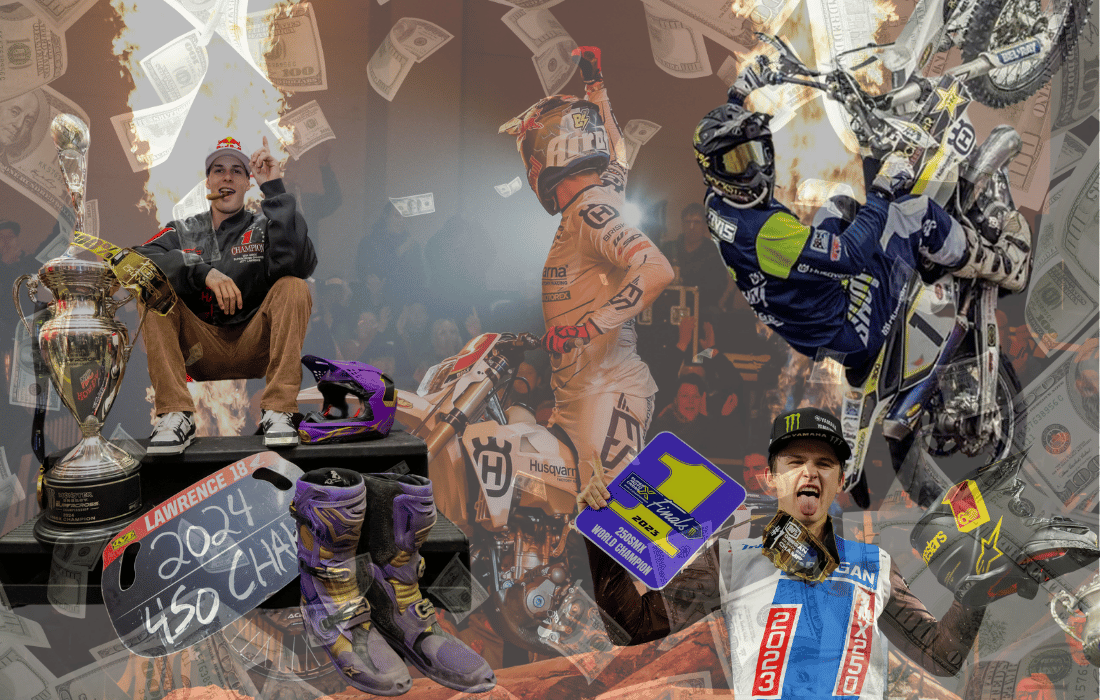Dirt bike racing is undergoing a fascinating transformation. From the rugged early days of off-road motorcycling to today’s polished arenas of Supercross and the grueling endurance challenges of enduro, the sport is enjoying significant growth both financially and culturally. With expanding audiences, emerging stars, and new ways to engage fans, dirt bike racing is poised to achieve unprecedented heights.
However, this growth has not been without its challenges. The sport’s history is filled with triumphs, setbacks, and lessons learned, making it an exciting case study in how niche motorsports adapt to the evolving demands of modern audiences. This article dives into the history, financial growth, cultural challenges, and the personalities driving dirt bike racing forward.
A History Forged in Mud: The Roots of Dirt Bike Racing
Dirt bike racing’s origins are as gritty as the tracks themselves. Emerging in the early 20th century, off-road motorcycle racing was a natural outgrowth of the motorcycle boom. Events like the International Six Days Trial (ISDT), first held in 1913, were among the earliest examples of organized off-road competition, testing riders’ endurance across diverse terrains. By the 1930s and 1940s, motocross (then called “scrambles”) began to gain popularity in Europe, particularly in the UK, Belgium, and Sweden.
Post-World War II, motocross became a symbol of resilience, with soldiers returning home and embracing the sport as a recreational outlet. By the 1950s, the FIM Motocross World Championship established a formal competitive framework, turning motocross into an international spectacle. Brands like Husqvarna, BSA, and CZ rose to prominence, creating specialized bikes that pushed the sport forward.
The 1970s brought motocross to the United States, where it adapted to the country’s rugged terrains and appetite for motorsports. Supercross emerged as a stadium-based variation, offering fans a more accessible, high-energy experience. Riders like Bob Hannah and Marty Smith became early icons, drawing large crowds to the growing Supercross series.
Market Expansion and Financial Projections
The off-road motorcycle market has experienced significant financial growth, driven by increased consumer interest, the entry of new manufacturers, and substantial sponsorship investments.
In 2021, the global off-road motorcycle market was valued at approximately USD 14.34 billion. Projections indicate a compound annual growth rate (CAGR) of 6.2%, with expectations to reach USD 21.83 billion by 2028.
Supercross has thrived due to its stadium-friendly format, facilitating broadcasting and marketing efforts. The Monster Energy AMA Supercross Championship, for instance, averaged a Total Audience Delivery of 502,000 viewers across NBC, USA Network, and Peacock in 2024, marking a 26% increase from the previous year.
This growth is bolstered by sponsorships from brands like Monster Energy, Toyota, and Red Bull. Conversely, the Red Bull Pro Motocross series, with its outdoor venues, maintains a dedicated fan base and benefits from streaming platforms such as Peacock and NBC Sports, which have expanded its global reach.
Enduro racing, often likened to the marathon of dirt biking, is experiencing steady growth. Its association with the adventure riding community and high-profile events like the Dakar Rally attract fans beyond traditional motorsports.
Entry of Major Manufacturers
The market’s expansion is further bolstered by the entry of prominent manufacturers:
Triumph Motorcycles: Triumph has introduced the TF 250-X, a state-of-the-art motocross bike, and established race teams to compete in both Supercross and outdoor motocross events.
Ducati: Ducati has unveiled the Desmo450 MX prototype and formed the Ducati Corse R&D Factory MX Team, marking its official entry into motocross racing.
- GasGas: GasGas has strengthened its presence in the FIM Motocross World Championship by consolidating its racing efforts into a unified team, featuring top-tier riders across MXGP and MX2 classes.
These strategic moves by established brands signify a robust commitment to the off-road segment, enhancing competition and innovation.
Advancements in Electric Off-Road Motorcycles
Aligning with the global shift towards sustainability, the off-road motorcycle market is witnessing significant advancements in electric models. Manufacturers are investing in electric off-road motorcycles to cater to environmentally conscious consumers, indicating a transformative trend in the industry.
The Super-Athlete Era: Homogenization of Rider Personalities
Ricky Carmichael, often referred to as “The GOAT” (Greatest of All Time), set unprecedented standards in motocross with his exceptional fitness and discipline. His dominance, which includes 15 AMA championships, reshaped the sport’s competitive landscape.
Following Carmichael, riders like Ryan Villopoto adopted similar rigorous training regimens, leading to a generation of athletes who prioritized physical preparation. While this elevated the sport’s competitive level, it also resulted in a homogenization of rider personalities. Podium interviews became formulaic, with athletes routinely listing sponsors without offering personal insights or expressions of individuality. This uniformity made it challenging for fans to connect with riders on a personal level, potentially limiting the sport’s broader appeal.
Jett Lawrence: The Australian Prodigy
 At just 21 years old at the time of writing this (Dec. 2024), Australian rider Jett Lawrence has rapidly ascended to the pinnacle of motocross. His exceptional skill and engaging personality have made him a standout figure. Lawrence’s career highlights include winning multiple 250 and 450 championships, with his most dominant and impressive being his perfect season in the 2023 450 outdoor Pro Motocross.
At just 21 years old at the time of writing this (Dec. 2024), Australian rider Jett Lawrence has rapidly ascended to the pinnacle of motocross. His exceptional skill and engaging personality have made him a standout figure. Lawrence’s career highlights include winning multiple 250 and 450 championships, with his most dominant and impressive being his perfect season in the 2023 450 outdoor Pro Motocross.
Beyond his on-track achievements, Lawrence has adeptly utilized social media to connect with fans, sharing insights into his training and personal life. This transparency has endeared him to a broad audience, attracting major sponsorships from brands like Alpinestars and Red Bull. His marketability and approachability are instrumental in bringing motocross into mainstream consciousness. Jett has all the potential in the world to be one of those guys who breaks through mainstream and becomes a household name, bringing more eyes and attention to the sport.
Haiden Deegan: The Legacy Continues
Haiden Deegan, known as “DangerBoy,” is following in the footsteps of his father, freestyle motocross legend Brian Deegan. Born in 2006, Haiden has quickly made a name for himself with a series of impressive performances. Notably, he secured the 2023 AMA 250SX Rookie of the Year title and has multiple AMA Pro Motocross 250 wins to his credit.
Deegan’s rise is also marked by a strong social media presence, offering fans a glimpse into his racing journey and personal experiences. This engagement has cultivated a dedicated fan base and attracted sponsorships, positioning him as a future star in the sport.
Both Lawrence and Deegan exemplify a new generation of riders who blend competitive excellence with personal branding, enhancing the appeal of motocross and Supercross to wider audiences.
The Power of Personal Stories: Beyond the Champions
One of the most exciting aspects of dirt bike racing today is the focus on the broader community of athletes. While there can only be one champion in each class, the sport is filled with incredible racers who have compelling stories, unique upbringings, and dynamic personalities.
Take Jorge Prado, for example, the Spanish MXGP champion who is crossing over to race in the American series. Prado brings an international flair to the sport and has the potential to become a global ambassador for motocross. His journey from European circuits to the U.S. showcases the growing interconnectedness of the sport on a global scale.
Similarly, in Enduro, riders like Graham Jarvis and Billy Bolt have built reputations not just for their skills but for their perseverance and creativity in tackling some of the world’s toughest terrains. Jarvis, known as the “King of Hard Enduro,” has inspired countless fans with his ability to conquer seemingly impossible obstacles, while Bolt represents the next generation of talent, blending skill with a vibrant social media presence.
These stories matter because they make the sport more relatable and engaging. Fans are drawn to athletes who are not just competitors but storytellers, adventurers, and role models.
Cultural and Logistical Challenges
Despite its growth, dirt bike racing faces several challenges. One of the biggest hurdles is accessibility. Motocross and enduro events often take place in remote locations, making them harder to reach for casual fans and media crews. Supercross has solved this problem with its stadium-based format, but the other disciplines still struggle to expand their audience beyond hardcore enthusiasts.
Another challenge is the perception of dirt bike racing as a niche sport. While motocross and Supercross enjoy significant followings in the U.S., and enduro has a strong foothold in Europe, these sports lack the global appeal of motorsports giants like Formula One or MotoGP. Overcoming this perception will require targeted marketing efforts, international events, and better media coverage.
The Future of Dirt Bike Racing
The future of dirt bike racing looks bright, thanks to emerging stars, expanding digital platforms, and a renewed focus on individuality. Athletes like Jett Lawrence, Haiden Deegan, and Jorge Prado are not just exceptional riders—they are personalities who can transcend the sport and bring it to new audiences.
Additionally, the rise of streaming platforms and social media has democratized access to dirt bike racing. Fans can now watch races, follow their favorite riders, and engage with the sport like never before. This increased visibility is helping dirt bike racing reach new markets and demographics.
Finally, the sport is beginning to embrace its diversity. From the high-energy spectacle of Supercross to the rugged endurance of enduro, dirt bike racing offers something for everyone. By highlighting the unique stories of its athletes and expanding its global footprint, the sport is well-positioned to grow in the coming decades.
Dirt bike racing is more than just a motorsport—it’s a culture, a community, and a way of life. With its mix of history, innovation, and raw excitement, it has all the ingredients to become a global phenomenon. The journey from muddy fields to international arenas is far from over, and the next chapter promises to be the most exciting yet.







